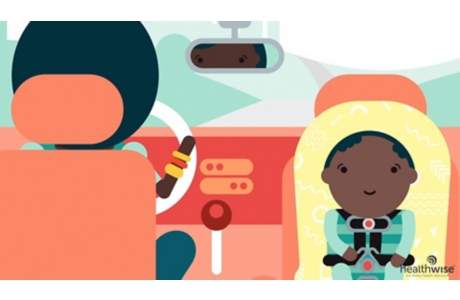child car seats
overview
infant and child car safety seats save lives. a child who is not in a car seat can be badly injured or killed during a crash or an abrupt stop. this can happen even at low speeds. a parent's arms are not strong enough to hold and protect a baby during a crash. many children who are not restrained die because they are torn from an adult's arms during a crash.
for every ride in a car, make sure your child is securely strapped into a car seat. make sure the car seat is properly installed and meets all current safety standards. always read and follow the guidelines and instructions provided by the maker of your car seat.
car seat requirements
infant and child car seats save lives. by law, children must be buckled up in a car seat that is made for their weight, height, and age.
for maximum safety, follow the manufacturer's recommendations for car seat use. use the universal anchorage system (uas) if you have it in your car. this feature allows parents to secure the car seat onto a permanently installed hook. check your car owner's manual for more information. don't buy a used car seat. if a car seat has been recalled or has been in an crash or misused, it may not fully protect your baby.
visit the child car seat safety web page at https://tc.canada.ca/en/road-transportation/child-car-seat-safety for more information. the following guidelines are from transport canada.
stage 1: rear facing
use a rear-facing car seat that faces the back of the car for your baby. it is safest for your baby to remain in a rear-facing infant seat until he or she reaches the maximum weight or height allowed by the car seat's manufacturer. when your child outgrows a rear-facing infant seat, look for another rear-facing car seat.
stage 2: forward-facing
use a car seat that faces the front (called forward-facing) and has a harness. use a forward-facing seat when your child outgrows the maximum weight or height allowed by the manufacturer of the rear-facing infant seat. keep using a forward-facing seat until your child no longer fits in it. some infant seats can be converted into forward-facing seats.
stage 3: booster seats
use a booster seat with a regular lap and shoulder belt for children who have outgrown their forward-facing car seats. booster seats raise the child up so that the lap and shoulder seat belts fit properly. adjust the shoulder belt to fit across the shoulder, not the neck. adjust the lap belt to fit across the hips, not the stomach. use this type of seat until adult seat belts fit your child correctly.
stage 4: seat belts
keep your child in a booster seat until your child is big enough to fit in a seat belt properly. for a seat belt to fit properly, the lap belt must lie snugly across the upper thighs, not the stomach. the shoulder belt should lie snug across the shoulder and chest and not cross the neck or face. remember: your child should still ride in the back seat because it's safer there.
proper positioning
- the safest place for your baby or child is in the middle of the back seat in the correct car or booster seat.
- never place your child's car seat in the front seat of any vehicle.
- put your infant's car seat at an angle where their head does not flop forward.
- use the universal anchorage system (uas) if you have it in your car. this feature allows parents to secure the car seat onto a permanently installed hook. check your car owner's manual for more information.
- don't buy a used car seat. if a car seat has been recalled or has been in an crash or misused, it may not fully protect your baby.
- if your child needs attention while you are driving, stop the car. then take care of your child's needs. don't let your child get out of their seat while the car is moving.
credits
current as of: october 24, 2023
author: healthwise staff
clinical review board
all healthwise education is reviewed by a team that includes physicians, nurses, advanced practitioners, registered dieticians, and other healthcare professionals.
current as of: october 24, 2023
author: healthwise staff
clinical review board
all healthwise education is reviewed by a team that includes physicians, nurses, advanced practitioners, registered dieticians, and other healthcare professionals.
